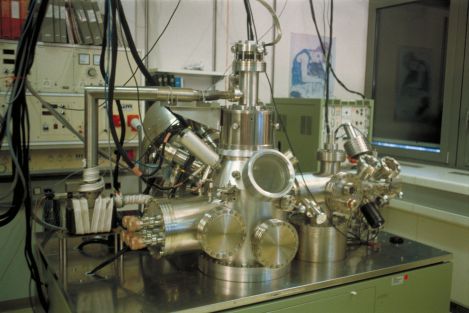ESCA - Electron Spectroscopy for Chemical Analysis
ESCA is a most sensitive surface analytical technique performed
under UHV conditions (10-11 mbar). The sample can be
analysed using X-ray or electron radiation. Two ion sources are
mounted to perform depth profiling and sample cleaning. Furthermore
we have the possibility to thermally coat or sputter coat the
samples in situ. Additional a mass spectrometer is used to identify
volatile compounds adsorbed onto the samples. In addition we
constructed special equipment in order to perform quasi in situ
analysis of thin films deposited electrochemically or by
adsorption.
In cooperation with the ECHEM -
Center of Competence for Applied Electrochemistry we designed
an apparatus to investigate the initial stages of the formation of
electrochemical layers. Besides the electrochemical cell made of
glass it consists of a transfer mechanism which guarantees a
controlled and well reproducible dipping of the sample into the
electrolyte. To avoid contamination of the sample surface the
deposition procedure is performed under an inert gas atmosphere.
The apparatus is attached to a commercial ESCA-Lab X-ray
photoelectron spectrometer via a custom designed transfer chamber.
The figure shows a schematic drawing of the setup. More information
on the experimental details and on the measurements performed can
be found in this PhD thesis (in
German only, 5.56MB!).
We perform our ESCA experiments on a VG Microlab Mark 2.

Another field of research is the analysis of films formed by additives whether through adsorption from liquids in the experimental setup described above or formed by tribologic stress. Using ESCA we identify the chemical composition of the films. Beyond the scope of normal ESCA angle resolved ESCA shows the depth distribution of the various compounds of the films. In case of additives with different compounds we can identify the compounds, which are next to the substrate and the ones next to the surface. We can distinguish between additives forming a closed film or islands on the surface. Furthermore the thickness of the films may be calculated by comparison to spectra simulated with SESSA.
